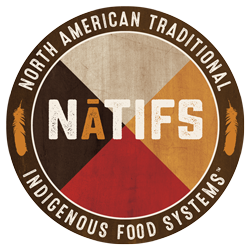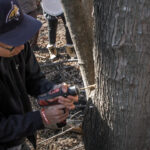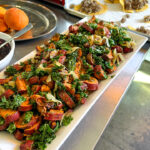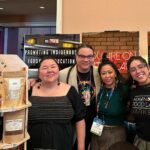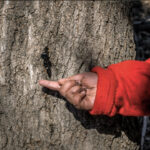In his talks, NATIFS Founder and Executive Director Sean Sherman often describes Pine Ridge Reservation in South Dakota, where he grew up, as one the poorest municipalities in the country – with about an 80 percent unemployment rate.
Pine Ridge has the lowest life expectancy in the Western Hemisphere, besides Haiti. Obesity, diabetes, and heart disease are major factors in this statistic – owing greatly to the population’s separation from Indigenous diets and the introduction of government commodity foods bearing little nutritional value.
But Red Cloud Indian School, a private, K-12 Catholic school – once a Holy Rosary Mission boarding school – is currently educating over 600 Lakota kids with an emphasis on Lakota culture. In a video entitled “What Red Cloud Students Dream Of,” many of the students report dreaming of speaking fluent Lakota one day. The school takes its namesake from Chief Red Cloud, a great leader of the Oglala Lakota, leading the most successful military campaign ever waged against the United States by an Indigenous group.
In addition to Lakota language, arts, and culture programs, the school kitchen has committed to bringing in culturally appropriate Indigenous lunches at least once weekly, with the help of NATIFS and the team at Indigenous Food Lab. In an area of the country where disenfranchisement is a common experience of the population, Red Cloud School wants its students to feel hope. Pride in culture is one of the ways it’s feeding into that hope.
“Wopila Wednesdays,” (in reference to the Lakota word for thanks and gratitude) along with a broader food curriculum like plant walks, gardening, and raising chickens, is becoming an intrinsic part of student life at Red Cloud. Esperanza Hartman, Lakota Cultural Food Coordinator at the school notes that nothing was approaching this kind of programming when she attended the school where she now works.
“We just got the pre-packaged lunches from the corporations and stuff like that. So, to be able to have these recipes that have traditional ingredients in them is really, really cool. And it’s especially cool when the students are excited about it and say, ‘Oh! I eat wild rice at home and now we’re going to get it in the cafeteria!’ That’s cool stuff to hear,” she explains.
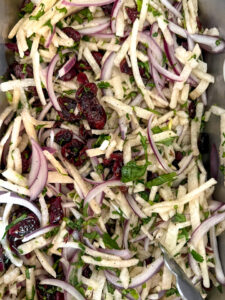
Above: Jicama Cranberry Coleslaw, one of the recipes written for the Red Cloud Project
The Indigenous Food Lab has been working for several months to help provide scalable, delicious, and nutritious recipes to Red Cloud so that the culinary team there can integrate the lunches with culturally appropriate ingredients and preparations.
It’s a project that has taken a lot of time and effort – including the allocation of NATIFS funding to help replace the kitchen equipment at Red Cloud, which had not been updated since the 1970s. Without this step, the program would have been difficult to implement.
NATIFS’ goal is to offer recipes that incorporate one hundred percent Native sourced ingredients, and the culinary team at IFL is also tasked with ensuring that the recipe is nutritionally sound for school lunch program guidelines.
As part of the curriculum and educational programming around the project, the kindergarten and grade school students are provided a recipe to take home and make with their families before the school lunch with the same recipe is rolled out.
“Which is just super cool,” says Liz Cates, NATIFS Project Coordinator on the program. They add that kids have gotten involved with naming some of the dishes – “They didn’t like the name ‘Meat Pie,’ for instance, so we can think about how we make these things more appealing, right?” But, they say, feedback has been mostly positive, particularly with the kids.
The culinary team at IFL has been using the project as an opportunity for inspiration, with culinary leader Ismael Popoca Aquilar implementing Tlyudas, for instance, a traditional dish from his native Mexico, utilizing Hoja Santa, a popular Mexican herb, but one that wouldn’t show up in typical American recipes, much less school lunch programs.
“It gives the dish a touch of authenticity,” he said.
Bison, wild rice, duck, and some other more traditional Indigenous ingredients are being incorporated into many of the menus, but Popoca Aguilar added that IFL ethnobotanist Linda Black Elk has been pushing the team to think outside of ingredients and preparations that are tried and true, but to also incorporate wild and seasonal ingredients too, like Lotus Root, an Indigenous root vegetable not commonly associated with Indigenous food.
Now that the program is up and running well, Hartman is looking forward to the day that traditional Indigenous foods are just an ordinary part of school life at Red Cloud.
“My hope is that soon we won’t be making a huge deal out of it. I hope traditional food just becomes a part of the norm here, and we won’t have to stress the importance of it all the time.”
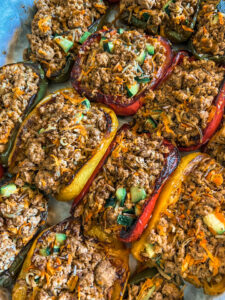
Above: Stuffed Bell Peppers, one of the recipes written for the Red Cloud Project
